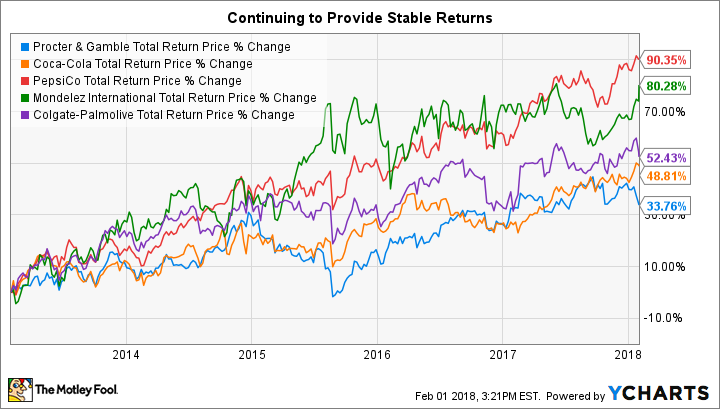Death of Big Brands: 5 “Safe” Dividend Stocks That Could Be Headed for Trouble
In late January 2018, former hedge fund manager Mike Alkin gave a talk at a Vancouver investing conference that all investors should watch, particularly those relying on big-brand dividend stocks for income. In it, he had a simple message:"Don't confuse a brand you know with a stock you should own."
Consumer staple stocks, he argued, are in for a very tough stretch. Since the Great Recession, many big names have actually seen sales fall. But earnings have been propped up by share buybacks and massive cuts to operating expenses.
Those forces, he argued, can only keep stocks afloat for so long. There's a reckoning on the horizon -- baby boomers will spend less on these brands in retirement, and millennials don't care about traditionally strong brands. The most dangerous of these stocks have lofty valuations that don't reflect this reckoning.

Image source: Getty Images
After doing some digging, I've found five prime candidates that fit this profile. All are dividend stalwarts, and I'm predicting all will significantly underperform the S&P 500 over the coming years -- a sentiment backed by my own CAPS ratings.
Company | Primary Products | Reason to Worry | 5-Year Revenue Change |
|---|---|---|---|
Coca-Cola (NYSE: KO) | Coke, Sprite, Dasani | People are learning more about how sugar isn't good for health. | (22%) |
PepsiCo (NASDAQ: PEP) | Pepsi, Gatorade, Lay's | Same as above, plus snack chips aren't healthy either. | (3%) |
Colgate-Palmolive (NYSE: CL) | Colgate, Palmolive, Hill's Pet Food | E-commerce is breaking down the brand; millennials favor small and local businesses. | (10%) |
Procter & Gamble (NYSE: PG) | Gillette, Pampers, Tide | It's a new e-commerce marketing era (see Dollar Shave). | (20%) |
Mondelez (NASDAQ: MDLZ) | Oreo, Nabisco, Wheat Thins | Millennials favor small, local companies and organic fare. | (27%) |
Data source: YCharts.
It's important to remember that this negative sales trend has occurred over a five-year time span when the economy was growing and unemployment levels were sinking to record lows. If you can't grow sales in the good times, what will happen when the stuff really hits the fan?
Here's how they were kept afloat
And yet, despite all this, shareholders in these companies have been rewarded with positive gains. While they might not be market-beating, they're probably more than good enough for income investors nearing or in retirement.
PG Total Return Price data by YCharts
Part of this is due to the fact that the above figures include the positive impact of dividend reinvestment. But part of it is simply because the companies have been able to keep their earnings afloat with some savvy moves -- borrowing low-interest money to buy back shares and slashing operating expenses.
Company | Shares Outstanding Change (5 Years) | Operating Expenses Change (5 Years) |
|---|---|---|
Coke | (4%) | (15%) |
Pepsi | (8%) | (3%) |
Colgate-Palmolive | (6%) | (10%) |
Procter & Gamble | (8%) | (29%) |
Mondelez | (16%) | (29%) |
Data source: YCharts.
Of course, there's nothing wrong with such moves. In fact, they are smart -- borrowing costs have been cheap, and cutting the fat from operations is part of the goal of capitalism. The problem, however, is simple: Such moves aren't sustainable.
The coming reckoning
Interest rates are going to be climbing higher in the year ahead, so the bevy of repurchases is likely to slow. More importantly, the cost-cutting has hit a necessary plateau. That means that without a pick-up in sales, all five of these companies may be falling short of earnings estimates in the year ahead.
As Alkin pointed out, millennials favor their consumer staples coming from companies that share three characteristics: they are small, they are local, and -- when applicable -- they sell organic goods.

Image source: Getty Images
Of course, the big players can just buy those smaller companies -- something Fool.com's own Asit Sharma has detailed -- but then millennials just rotate toward a different independent brand. That's great for local economies, but not so great for investors counting on such companies.
Just as alarming, the aforementioned rate raises could cause what Alkin calls "yield tourists" to sell their shares of such companies to "safer" investments in money markets or bonds. This doesn't necessarily mean that these companies will disappear overnight. Many of them still have strong free cash flows that can support continued dividend growth.
But that's where the danger lies. Brands take time to die. The free cash flow provided because of the brands will make the dividends look sustainable. If these stocks fall based on fundamentals, the dividend yields will go even higher, attracting unsuspecting investors. Once the free cash flows have been tapped, you don't want to be left holding the bag.
More From The Motley Fool
Brian Stoffel has no position in any of the stocks mentioned. The Motley Fool has no position in any of the stocks mentioned. The Motley Fool has a disclosure policy.

 Yahoo Finance
Yahoo Finance 
